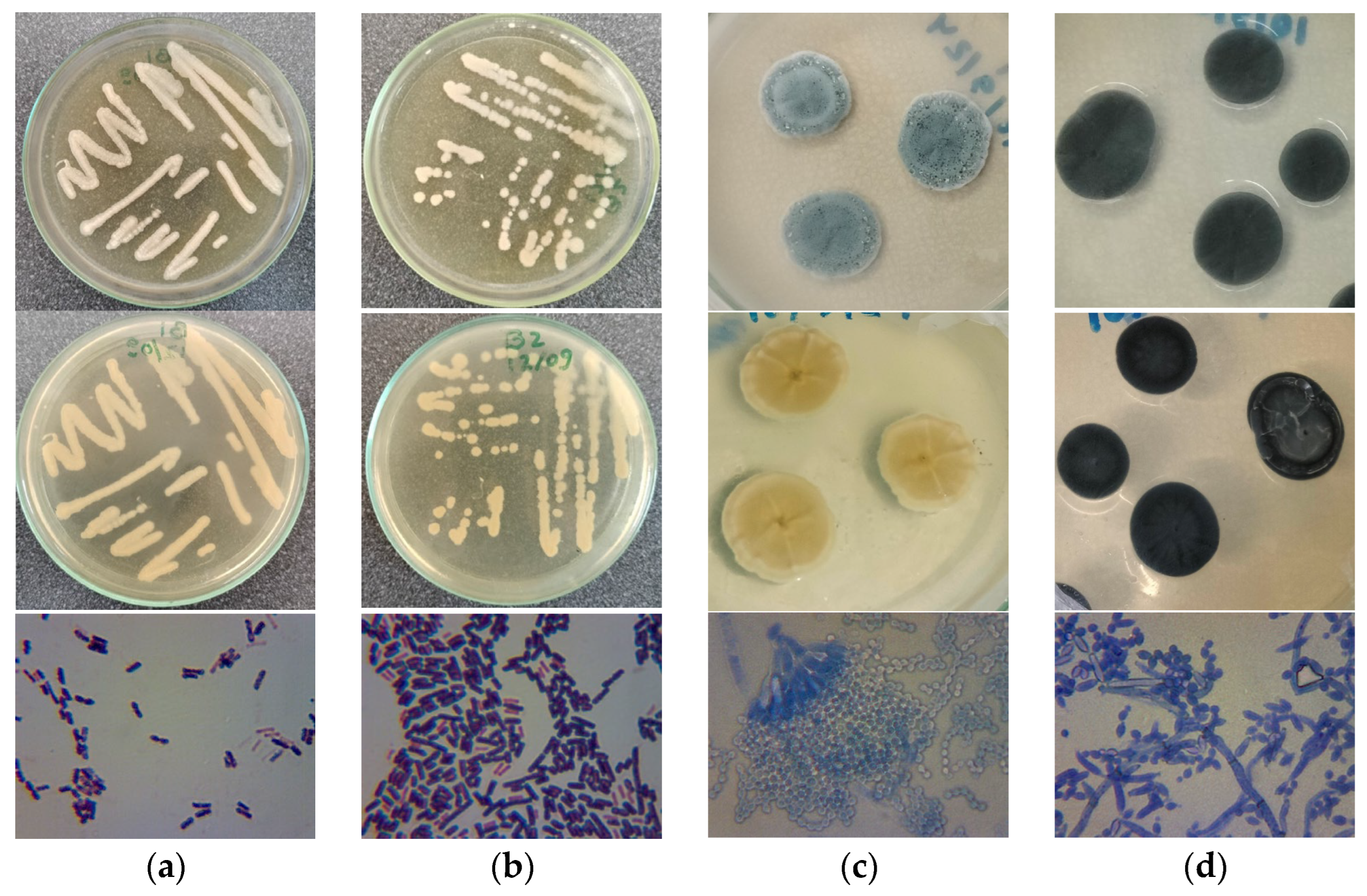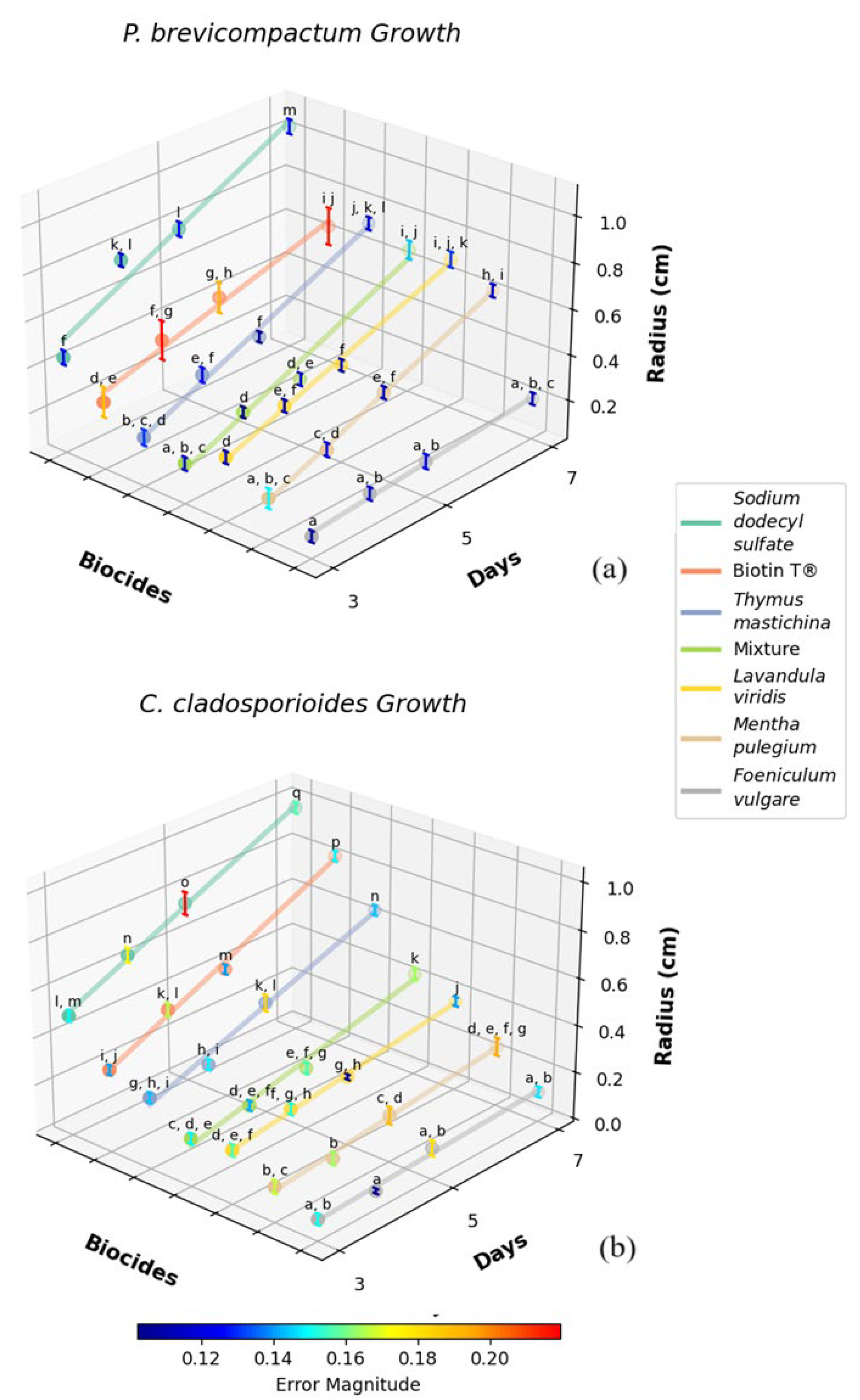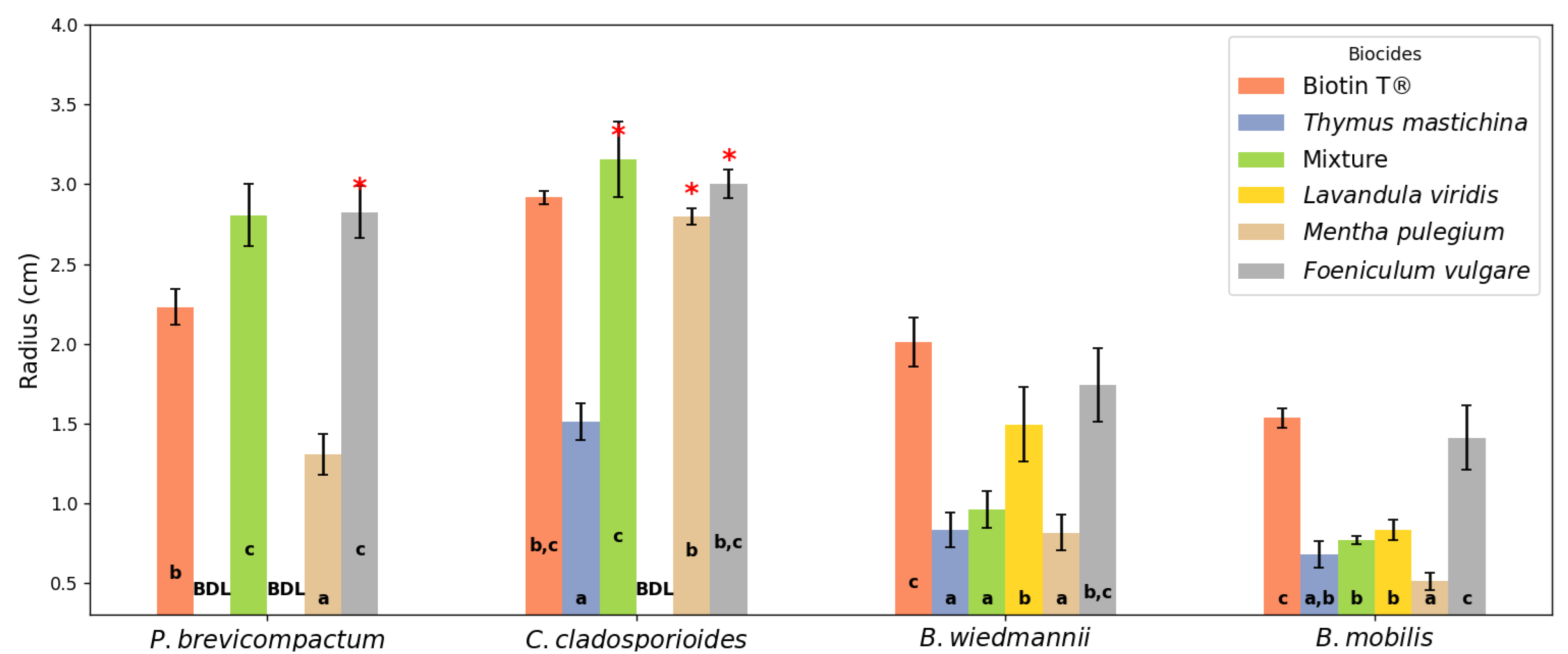Biocides Based on Essential Oils for Sustainable Conservation and Restoration of Mural Paintings in Built Cultural Heritage
Abstract
1. Introduction
2. Materials and Methods
2.1. Site Description
2.2. Microorganisms Isolation: Morphological Characterization and Molecular Identification
2.3. Essential Oil Obtention and Stock Biocide Solution Preparation
2.4. Biocidal Potential Assessment
2.5. Statistical Analysis
3. Results and Discussion
3.1. Microorganism Isolation and Identification
3.2. Biocidal Potential Assessment
3.2.1. Antifungal Activity Assessed by Micro-Atmosphere Method
3.2.2. Antimicrobial Activity Assed by Contact Method
4. Conclusions
Author Contributions
Funding
Institutional Review Board Statement
Informed Consent Statement
Data Availability Statement
Acknowledgments
Conflicts of Interest
References
- Schröer, L.; Boon, N.; De Kock, T.; Cnudde, V. The Capabilities of Bacteria and Archaea to Alter Natural Building Stones—A Review. Int. Biodeterior. Biodegrad. 2021, 165, 105329. [Google Scholar] [CrossRef]
- Sterflinger, K.; Pinzari, F. The Revenge of Time: Fungal Deterioration of Cultural Heritage with Particular Reference to Books, Paper and Parchment. Environ. Microbiol. 2012, 14, 559–566. [Google Scholar] [CrossRef] [PubMed]
- Crispim, C.A.; Gaylarde, C.C. Cyanobacteria and Biodeterioration of Cultural Heritage: A Review. Microb. Ecol. 2005, 49, 1–9. [Google Scholar] [CrossRef]
- Russo, R.; Palla, F. Plant Essential Oils as Biocides in Sustainable Strategies for the Conservation of Cultural Heritage. Sustainability 2023, 15, 8522. [Google Scholar] [CrossRef]
- Ahmed, E.A.-E.; Mohamed, R.M. Bacterial Deterioration in the Limestone Minaret of Prince Muhammad and Suggested Treatment Methods, Akhmim, Egypt. Geomaterials 2022, 12, 37–58. [Google Scholar] [CrossRef]
- Mateus, D.M.R.; Silva, R.B.; Costa, F.M.C.; Coroado, J.P.F. Microbiological Diversity in the Unfinished Sacristy Building of the Convent of Christ, Tomar, and Evaluation of Its Biocide-Based Control. Conserv. Património 2013, 17, 11–20. [Google Scholar] [CrossRef]
- Di Carlo, E.; Chisesi, R.; Barresi, G.; Barbaro, S.; Lombardo, G.; Rotolo, V.; Sebastianelli, M.; Travagliato, G.; Palla, F. Fungi and Bacteria in Indoor Cultural Heritage Environments: Microbial-Related Risks for Artworks and Human Health. Environ. Ecol. Res. 2016, 4, 257–264. [Google Scholar] [CrossRef]
- Resende, M.A. De Biodeterioração de Monumentos Históricos. In Microbiologia Ambiental; de Azevedo, J.L., de Melo, I.S., Eds.; Embrapa Meio Ambiente: Jaguariúna, SP, Brazil, 2008; pp. 501–520. [Google Scholar]
- Văcar, C.L.; Mircea, C.; Pârvu, M.; Podar, D. Diversity and Metabolic Activity of Fungi Causing Biodeterioration of Canvas Paintings. J. Fungi 2022, 8, 589. [Google Scholar] [CrossRef] [PubMed]
- Baptista Neto, J.A.; Gaylarde, C.; Beech, I.; Smith, B.J.; McAlister, J.J. Degradação de Gnaisse e Granito Em Fachadas de Edifícios Históricos No Centro Do Rio de Janeiro. Sistemas Gestão 2020, 15, 80–90. [Google Scholar] [CrossRef]
- Liu, X.; Koestler, R.J.; Warscheid, T.; Katayama, Y.; Gu, J.-D. Microbial Deterioration and Sustainable Conservation of Stone Monuments and Buildings. Nat. Sustain. 2020, 3, 991–1004. [Google Scholar] [CrossRef]
- Sterflinger, K.; Piñar, G. Microbial Deterioration of Cultural Heritage and Works of Art—Tilting at Windmills? Appl. Microbiol. Biotechnol. 2013, 97, 9637–9646. [Google Scholar] [CrossRef]
- Shirakawa, M.A.; John, V.M.; Cincotto, M.A. Biodeterioração No Ambiente Construído. In Microbiologia Ambiental; de Melo, I.S., de Azevedo, J.L., Eds.; Embrapa Meio Ambiente: Jaguariúna, SP, Brazil, 2008; pp. 478–499. [Google Scholar]
- Allsopp, D.; Seal, K.J.; Gaylarde, C.C. Introduction to Biodeterioration; Cambridge University Press: Cambridge, MA, USA, 2004; ISBN 9780521528870. [Google Scholar]
- Mateus, D.M.R.; Costa, F.M.C.; Triães, R.P. Essential Oils of Plants as Biocides Against Microorganisms Isolated from Portuguese Convent of Christ in Tomar; Springer International Publishing: Cham, Switzerland, 2023; pp. 129–139. [Google Scholar]
- Cappitelli, F.; Abbruscato, P.; Foladori, P.; Zanardini, E.; Ranalli, G.; Principi, P.; Villa, F.; Polo, A.; Sorlini, C. Detection and Elimination of Cyanobacteria from Frescoes: The Case of the St. Brizio Chapel (Orvieto Cathedral, Italy). Microb. Ecol. 2009, 57, 633–639. [Google Scholar] [CrossRef] [PubMed]
- Palla, F.; Bruno, M.; Mercurio, F.; Tantillo, A.; Rotolo, V. Essential Oils as Natural Biocides in Conservation of Cultural Heritage. Molecules 2020, 25, 730. [Google Scholar] [CrossRef]
- Bhatnagar, P.; Khan, A.A.; Jain, S.K.; Rai, M.K. Biodeterioration of Archaeological Monuments and Approach for Restoration. In Geomicrobiology; Jain, S.K., Khan, A.A., Rai, M.K., Eds.; CRC Press Taylor and Francis Group Science Publishers: Boca Raton, FL, USA, 2010; pp. 255–302. [Google Scholar]
- Liu, X.; Qian, Y.; Wu, F.; Wang, Y.; Wang, W.; Gu, J.-D. Biofilms on Stone Monuments: Biodeterioration or Bioprotection? Trends Microbiol. 2022, 30, 816–819. [Google Scholar] [CrossRef]
- Cappitelli, F.; Cattò, C.; Villa, F. The Control of Cultural Heritage Microbial Deterioration. Microorganisms 2020, 8, 1542. [Google Scholar] [CrossRef] [PubMed]
- Pinna, D. Can We Do without Biocides to Cope with Biofilms and Lichens on Stone Heritage? Int. Biodeterior. Biodegrad. 2022, 172, 105437. [Google Scholar] [CrossRef]
- Fidanza, M.R.; Caneva, G. Natural Biocides for the Conservation of Stone Cultural Heritage: A Review. J. Cult. Herit. 2019, 38, 271–286. [Google Scholar] [CrossRef]
- Mateus, D.M.R.; Ferraz, E.; Perna, V.; Sales, P.; Hipólito-Correia, V. Essential Oils and Extracts of Plants as Biocides against Microorganisms Isolated from the Ruins of the Roman City of Conímbriga (Portugal). Environ. Sci. Pollut. Res. 2024, 31, 40669–40677. [Google Scholar] [CrossRef]
- Reale, R.; Medeghini, L.; Botticelli, M. Stealing from Phytotherapy—Heritage Conservation with Essential Oils: A Review, from Remedy to Sustainable Restoration Product. Sustainability 2024, 16, 5110. [Google Scholar] [CrossRef]
- Casorri, L.; Masciarelli, E.; Ficociello, B.; Ietto, F.; Incoronato, F.; Di Luigi, M.; Pacioni, G. Natural Substances as Biocides in the Fungi Treatment on Artistic Products to Protect the Environment and Health of Restoration Workers. Ital. J. Mycol. 2023, 52, 89–111. [Google Scholar]
- Angane, M.; Swift, S.; Huang, K.; Butts, C.A.; Quek, S.Y. Essential Oils and Their Major Components: An Updated Review on Antimicrobial Activities, Mechanism of Action and Their Potential Application in the Food Industry. Foods 2022, 11, 464. [Google Scholar] [CrossRef]
- Atanasov, A.G.; Waltenberger, B.; Pferschy-Wenzig, E.-M.; Linder, T.; Wawrosch, C.; Uhrin, P.; Temml, V.; Wang, L.; Schwaiger, S.; Heiss, E.H.; et al. Discovery and Resupply of Pharmacologically Active Plant-Derived Natural Products: A Review. Biotechnol. Adv. 2015, 33, 1582–1614. [Google Scholar] [CrossRef] [PubMed]
- Zaccardelli, M.; Roscigno, G.; Pane, C.; Celano, G.; Di Matteo, M.; Mainente, M.; Vuotto, A.; Mencherini, T.; Esposito, T.; Vitti, A.; et al. Essential Oils and Quality Composts Sourced by Recycling Vegetable Residues from the Aromatic Plant Supply Chain. Ind. Crops Prod. 2021, 162, 113255. [Google Scholar] [CrossRef]
- Gomoiu, I.; Cojoc, R.L.; Enache, M.I.; Neagu, S.E.; Mohanu, D.; Mohanu, I. Microbial Ability to Colonize Mural Painting and Its Substrate. Acta Phys. Pol. A 2018, 134, 383–386. [Google Scholar] [CrossRef]
- Wu, F.; Gu, J.-D.; Li, J.; Feng, H.; Wang, W. Microbial Colonization and Protective Management of Wall Paintings. In Cultural Heritage Microbiology-Recent Developments; Mitchell, R., Clifford, J., Vasanthakumar, A., Eds.; Archetype Publications: London, UK, 2022; pp. 57–81. [Google Scholar]
- Trovão, J.; Portugal, A. Current Knowledge on the Fungal Degradation Abilities Profiled through Biodeteriorative Plate Essays. Appl. Sci. 2021, 11, 4196. [Google Scholar] [CrossRef]
- Isola, D.; Bartoli, F.; Casanova Municchia, A.; Lee, H.J.; Jeong, S.H.; Chung, Y.J.; Caneva, G. Green Biocides for the Conservation of Hypogeal Mural Paintings Raised from Western and Eastern Traditions: Evaluation of Interference on Pigments and Substrata and Multifactor Parameters Affecting Their Activity. J. Cult. Herit. 2023, 61, 116–126. [Google Scholar] [CrossRef]
- Marco, A.; Santos, S.; Caetano, J.; Pintado, M.; Vieira, E.; Moreira, P.R. Basil Essential Oil as an Alternative to Commercial Biocides against Fungi Associated with Black Stains in Mural Painting. Build. Environ. 2020, 167, 106459. [Google Scholar] [CrossRef]
- Lee, H.-J.; Chung, Y.-J. Antifungal, Antibacterial, and Interference Effects of Plant-Extracted Essential Oils Used for Mural Conservation at Buyeo Royal Tomb No. 1. Appl. Sci. 2023, 13, 3645. [Google Scholar] [CrossRef]
- Verdier, T.; Coutand, M.; Bertron, A.; Roques, C. A Review of Indoor Microbial Growth across Building Materials and Sampling and Analysis Methods. Build. Environ. 2014, 80, 136–149. [Google Scholar] [CrossRef]
- Baptista, C.; Santos, L.; Emília Amaral, M.; Silva, L. Chemical Characterization of Essential Oils With a Biocide Base for Conservation and Restoration. KnE Mater. Sci. 2022, 7, 80–90. [Google Scholar] [CrossRef]
- Balouiri, M.; Sadiki, M.; Ibnsouda, S.K. Methods for in Vitro Evaluating Antimicrobial Activity: A Review. J. Pharm. Anal. 2016, 6, 71–79. [Google Scholar] [CrossRef] [PubMed]
- Stupar, M.; Grbić, M.L.; Džamić, A.; Unković, N.; Ristić, M.; Jelikić, A.; Vukojević, J. Antifungal Activity of Selected Essential Oils and Biocide Benzalkonium Chloride against the Fungi Isolated from Cultural Heritage Objects. S. Afr. J. Bot. 2014, 93, 118–124. [Google Scholar] [CrossRef]
- Paolino, B.; Sorrentino, M.C.; Troisi, J.; Delli Carri, M.; Kiselev, P.; Raimondo, R.; Lahoz, E.; Pacifico, S. Lavandula Angustifolia Mill. for a Suitable Non-Invasive Treatment against Fungal Colonization on Organic-Media Cultural Heritage. Herit. Sci. 2024, 12, 53. [Google Scholar] [CrossRef]
- Zerhouni, K.; Abbouni, B.; Kanoun, K.; Daouadji, K.L.; Tifrit, A.; Benahmed, M.; Chaouche, T.M. Isolation and Identification of Low Density Polythene-Degrading Bacteria from Soil of North West of Algeria. South Asian J. Exp. Biol. 2019, 8, 76–82. [Google Scholar] [CrossRef]
- Ünlü-Yokuş, Y.; Göksay-Kadaifçiler, D.; Ilhan-Sungur, E. Amylolytic and Proteolytic Bacteria in Deteriorated Paper-Based Historical Manuscripts. J. Sci. Ind. Res. 2024, 83, 1012–1021. [Google Scholar] [CrossRef]
- Ma, C.; Fang, Z.; Li, X.; Liu, X. Identification of Bacterial Communities Involved in Bioweathering Crusts on Limestone Sculptures of the Longmen Grottoes. Coatings 2023, 13, 1506. [Google Scholar] [CrossRef]
- Nigro, L.; Mura, F.; Toti, M.P.; Cirigliano, A.; Rinaldi, T. Carbonatogenic Bacteria on the ‘Motya Charioteer’ Sculpture. J. Cult. Herit. 2022, 57, 256–264. [Google Scholar] [CrossRef]
- Kalemba, D.; Kunicka, A. Antibacterial and Antifungal Properties of Essential Oils. Curr. Med. Chem. 2003, 10, 813–829. [Google Scholar] [CrossRef]
- Piccaglia, R.; Marotti, M.; Giovanelli, E.; Deans, S.G.; Eaglesham, E. Antibacterial and Antioxidant Properties of Mediterranean Aromatic Plants. Ind. Crops Prod. 1993, 2, 47–50. [Google Scholar] [CrossRef]
- Mota, A.S.; Martins, M.R.; Arantes, S.; Lopes, V.R.; Bettencourt, E.; Pombal, S.; Gomes, A.C.; Silva, L.A. Antimicrobial Activity and Chemical Composition of the Essential Oils of Portuguese Foeniculum Vulgare Fruits. Nat. Prod. Commun. 2015, 10. [Google Scholar] [CrossRef]
- Rodrigues, M.; Lopes, A.C.; Vaz, F.; Filipe, M.; Alves, G.; Ribeiro, M.P.; Coutinho, P.; Araujo, A.R.T.S. Thymus Mastichina: Composition and Biological Properties with a Focus on Antimicrobial Activity. Pharmaceuticals 2020, 13, 479. [Google Scholar] [CrossRef]
- Yasa, H.; Onar, H.Ç.; Yusufoglu, A.S. Chemical Composition of the Essential Oil of Mentha pulegium L. from Bodrum, Turkey. J. Essent. Oil Bear. Plants 2012, 15, 1040–1043. [Google Scholar] [CrossRef]
- Ouakouak, H.; Chohra, M.; Denane, M. Chemical Composition, Antioxidant Activities of the Essential Oil of Mentha pulegium L, South East of Algeria. Int. Lett. Nat. Sci. 2015, 39, 49–55. [Google Scholar] [CrossRef]
- Yamini, Y.; Sefidkon, F.; Pourmortazavi, S.M. Comparison of Essential Oil Composition of Iranian Fennel (Foeniculum vulgare) Obtained by Supercritical Carbon Dioxide Extraction and Hydrodistillation Methods. Flavour Fragr. J. 2002, 17, 345–348. [Google Scholar] [CrossRef]
- Kakakhel, M.A.; Wu, F.; Gu, J.-D.; Feng, H.; Shah, K.; Wang, W. Controlling Biodeterioration of Cultural Heritage Objects with Biocides: A Review. Int. Biodeterior. Biodegrad. 2019, 143, 104721. [Google Scholar] [CrossRef]







| Biocide | Penicillium brevicompactum | Cladosporium cladosporioides | ||||
|---|---|---|---|---|---|---|
| Radius ± CI (cm) | G.R. (cm/day) | C.D. | Radius ± CI (cm) | G.R. (cm/day) | C.D. | |
| Fennel | 0.12 ± 0.03 a | 0.031 | 0.92 | 0.08 ± 0.02 a,b | 0.017 | 0.86 |
| Lavender | 0.30 ± 0.03 d | 0.096 | 0.99 | 0.21 ± 0.02 d,e,f | 0.053 | 0.96 |
| Pennyroyal | 0.21 ± 0.04 a,b,c | 0.088 | 0.98 | 0.14 ± 0.03 b,c | 0.034 | 0.97 |
| Thyme | 0.24 ± 0.03 b,c,d | 0.101 | 0.98 | 0.29 ± 0.02 g,h,i | 0.091 | 0.99 |
| SDS | 0.45 ± 0.03 f | 0.15 | 0.97 | 0.50 ± 0.02 l,m | 0.139 | 0.99 |
| Mix | 0.20 ± 0.03 a,b,c | 0.09 | 0.93 | 0.19 ± 0.02 c,d,e | 0.058 | 0.97 |
| Biotin T® | 0.32 ± 0.07 d,e | 0.109 | 0.99 | 0.33 ± 0.02 i,j | 0.115 | 1.00 |
| Biocide | Penicillium brevicompactum | Cladosporium Cladosporioides | Bacillus wiedmannii | Bacillus mobilis |
|---|---|---|---|---|
| Radius ± CI (cm) | Radius ± CI (cm) | Radius ± CI (cm) | Radius ± CI (cm) | |
| Fennel | 2.83 ± 0.16 *,c | 3.00 ± 0.09 *,b,c | 1.74 ± 0.23 b,c | 1.41 ± 0.20 c |
| Lavender | N.D. | N.D. | 1.49 ± 0.23 b | 0.83 ± 0.06 b |
| Pennyroyal | 1.31 ± 0.13 a | 2.80 ± 0.05 *,b | 0.82 ± 0.11 a | 0.51 ± 0.05 a |
| Thyme | N.D. | 1.51 ± 0.11 a | 0.83 ± 0.11a | 0.68 ± 0.08 a,b |
| Mixture | 2.81 ± 0.20 c | 3.16 ± 0.24 c | 0.96 ± 0.11 a | 0.77 ± 0.03 b |
| Biotin T® | 2.23 ± 0.11 b | 2.92 ± 0.04 b,c | 2.01 ± 0.15 c | 1.53 ± 0.06 c |
Disclaimer/Publisher’s Note: The statements, opinions and data contained in all publications are solely those of the individual author(s) and contributor(s) and not of MDPI and/or the editor(s). MDPI and/or the editor(s) disclaim responsibility for any injury to people or property resulting from any ideas, methods, instructions or products referred to in the content. |
© 2024 by the authors. Licensee MDPI, Basel, Switzerland. This article is an open access article distributed under the terms and conditions of the Creative Commons Attribution (CC BY) license (https://creativecommons.org/licenses/by/4.0/).
Share and Cite
Mateus, D.; Costa, F.; de Jesus, V.; Malaquias, L. Biocides Based on Essential Oils for Sustainable Conservation and Restoration of Mural Paintings in Built Cultural Heritage. Sustainability 2024, 16, 11223. https://doi.org/10.3390/su162411223
Mateus D, Costa F, de Jesus V, Malaquias L. Biocides Based on Essential Oils for Sustainable Conservation and Restoration of Mural Paintings in Built Cultural Heritage. Sustainability. 2024; 16(24):11223. https://doi.org/10.3390/su162411223
Chicago/Turabian StyleMateus, Dina, Fernando Costa, Vasco de Jesus, and Leonor Malaquias. 2024. "Biocides Based on Essential Oils for Sustainable Conservation and Restoration of Mural Paintings in Built Cultural Heritage" Sustainability 16, no. 24: 11223. https://doi.org/10.3390/su162411223
APA StyleMateus, D., Costa, F., de Jesus, V., & Malaquias, L. (2024). Biocides Based on Essential Oils for Sustainable Conservation and Restoration of Mural Paintings in Built Cultural Heritage. Sustainability, 16(24), 11223. https://doi.org/10.3390/su162411223








